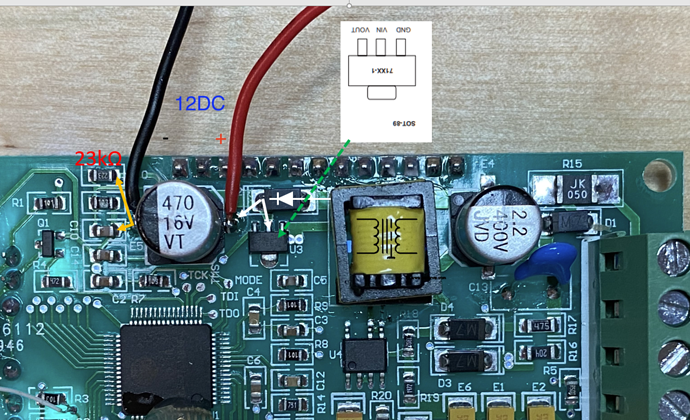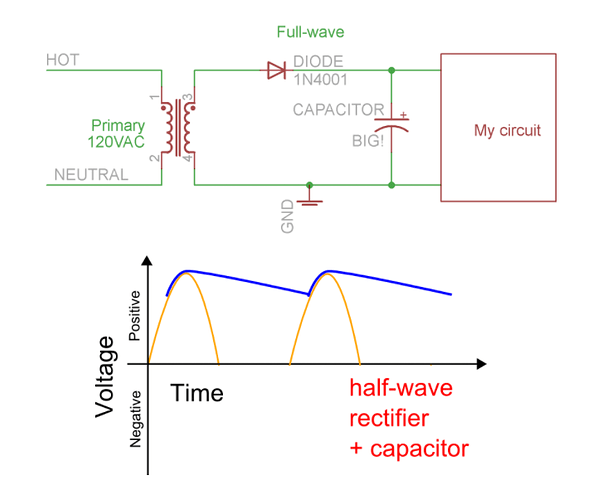Yeah. I did like the idea of having a local display as well as data published to home automation or some way to consume the data remotely. Thanks for the tip.
More or less similar results here.
I measure from 1 to 3 VAC between the Neutral and Earth legs at the wall sockets in my house.
And if your logic analyser is only good for 3.3 or even 5V and it has a path back to Earth (often through a USB connection to an earthed computer) that Neutral voltage can get high enough to fry its inputs.
just add local TFT connected to the esp. these work nice with wemos mini… and you can produce more interesting local informational display – oh well just a thought
Only in my dreams. I don’t (but wish I did) have one, ![]()
The low end (low speed, low channel count) USB ones are quite affordable and there’s pretty good opensource host s/w for displaying the results. Here’s a random example from a search (so not an endorsement): USB Logic Analyser
Right in the ol’ back yard. They’re (Sparkfun) only a couple of states away.
I’ve bought various items from them over the last 5 years or thereabouts.
Always got a good shake from them.
Good info. Thanks!
Now I just need to find a reason to buy one. 
Very similar to what i’ve used yes.
So sounds like the consensus is that it is probably not readily available?
Any feedback on whether trying to see whether this can be enabled with JTAG?
My understanding that branch panels are not “bonded” predates widespread ground-fault technology. I think the idea is that if a neutral imbalance current is allowed to return through the ground path, it could set up an inductive heating scenario for metallic enclosures.
Here’s why Neutrals and Grounds are kept separate in sub-panels:
Not because of inductive heating, but shock hazard.
Hi, I tried the 12V DC hack for this. I think it worked the first time but now my power meter is reading 2x the voltage I put in on the main line at the screw terminals. Any thoughts? I was going to try a minimal, 3V supply and see if that worked… I’m afraid I blew something with the 12V DC.
From what you write, that does seem likely - assuming that
means it worked AND gave credible readings.
I can’t imagine it will work with 3 V if it is designed for 12 V. Did you check that there was 12 V present from the normal power source at the place where you were going to inject your safe low voltage to carry out the investigation, before you connected it?
Hey Robert, thanks for getting back to me…
I’m just back from trying something else on a new power meter and it seemed to work… I must have damaged the original -022 meter.
My new procedure was to remove everything and just connect external DC supply leads on the 16V cap. I increased the DC voltage until the -022 turned on. This happened at about 3.5V DC. It read 0-1V and 0A on the -022 as expected. I then connected the Rogowski coil, and main leads from the variac into the -022, along with my isolated DC supply on that 16V cap at 3.5V DC. Again, 0-1V on the -022 without any variac output voltage…
I then slowly crept up the variac until the ~50V AC -022 meter turn on and I noticed my DC supply going up to about 5.5V DC… I went ahead to 120V AC and all seemed to work fine! (… for now : )
I figure my next step would be to read about building a standalone DC circuit which can either handle an extra voltage from the cap or some kind of circuit that decreases output voltage when it senses that supply voltage from the cap coming from the internal -022 circuit. What do ya think?
It’s not clear from that what you’re doing (and bear in mind, I don’t know the PZEM-022). I think you’re saying that when it’s deriving its power from the mains supply, there’s a place presumably on the output side of its (regulated ?) power supply where it sits at approx 5.5 V. That sounds much more like the sort of voltage I’d expect, and probably explains why you damaged the first one by feeding 12 V in there.
What’s your objective - to have it work down to zero supply voltage?
You need to find out where the 5.5 V is coming from. It might mean tracing out the circuit backwards from that smoothing/reservoir capacitor to the mains connector.
IF the first thing in the chain working backwards is a rectifier, then all you need to do is design a power supply with an output of not more than 6.0 V, and feed that into the circuit via a rectifier diode. Your power supply will automatically pick up the load when the mains drops such that the capacitor voltage would fall below 5.4 – 5.3 V, and the inbuilt supply will take over when the capacitor voltage is above that.
If however you come across a regulator i.c., you’ll need to find out how that behaves if you “backfeed” it, and that probably won’t be easy. It might well damage it, in which case you will have two destroyed PZEMs.
OK, thank you… Slow but steadily I’m getting through the circuit : )
I’ll show you what I found so far…
Borrowing from a previous upload… .I found that one transformer leg feeds a diode and that is attached directly to the capacitor which I was putting 3.5V on. There is a voltage regulator but it’s before the cap and after the diode. I see that no matter how much I increase the voltage past that “on” threshold, the voltage stays at about 5-5.5V DC. And yes, that’s what I wanted, to be able to read down to 0V as I may be interested in something like 20V, 30V, etc.
Borrowing from someone else, I think this may be how they are supplying the DC voltage for the interface:
I think I’ll go with your rectifier diode in this case…
That’s not quite what I expected, but it’s good enough. (I’d expected a full-wave bridge rectifier.)
If you put another similar diode with the anode fed from your 6 V regulated d.c., and the cathode to the junction of the regulator, diode and capacitor, and the negative of your supply to GND, you should be in business.
I don’t know if anyone still looks at this thread, but I got a couple of these meters, wanting to be able to monitor the current that my car audio amplifier is putting out. Is there an easy way to modify the PZEM-022 V2.0. to have the power supply to operate off 12v DC, and still monitor AC current. I am wanting it to read from 0 and up. If some one could simplify how to do that I would greatly appreciate it.
Welcome, Mathew, to the OEM forum.
Yes, we do (or at least, I see almost every post that appears. And the rogue ones hit the infinite bit bucket).
Without delving deeply into the PZEM, you need to find/construct a 12 V - 6 V (or thereabouts) step-down regulator, then proceed in exactly the same way. There’s no simpler way that I can think of.
I’ve no idea what the measurement bandwidth of the PZEM might be, I’d expect it to go no higher than a few kHz if that, so your measurements might lack accuracy. But you should get a reasonable indication if everything is moderately steady-state. I doubt you’ll get a meaningful reading on programme (music, but especially speech).
Thank you for your reply, It is just the bass that I’m wanting to measure, 80hz and below and from 0 to 3000 watts give or take. I’m not the greatest at working with circuit boards. So it’s there a a detailed how to duo this. I have common sense so would beable to do it. Would I have to separate the dc power and the AC power?


